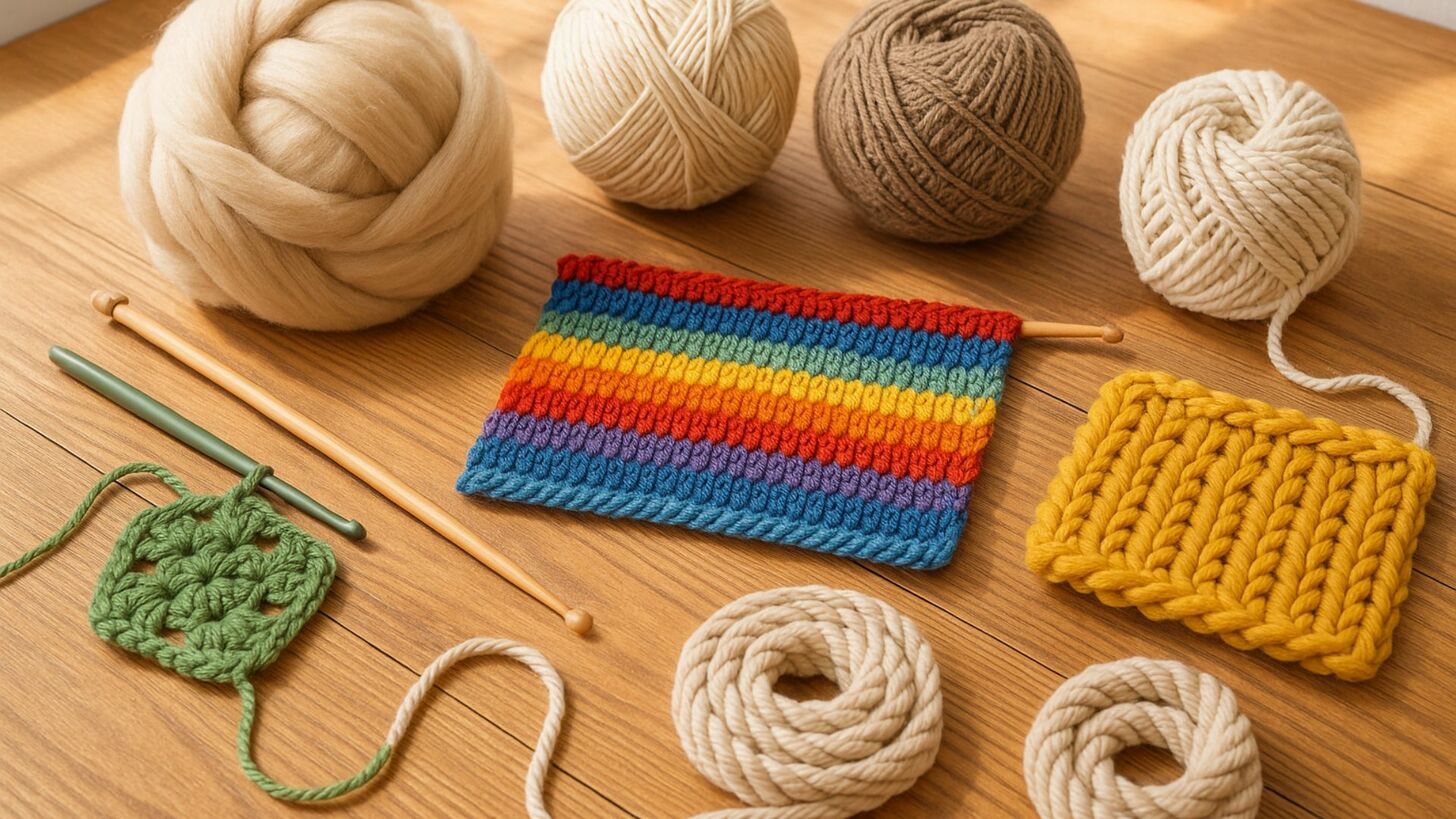
Have you ever stood in the yarn aisle, overwhelmed by choices, wondering which fiber would work best for your next project? You're not alone. The right yarn can make your project shine, while the wrong choice might leave you frustrated. In this guide, we'll explore different yarn fiber types and project ideas that showcase each yarn's unique qualities, helping you make confident choices for your next crafting adventure.
Understanding Yarn Fibers: The Basics
Yarn comes in three primary fiber categories, each with distinct characteristics that affect how your finished project looks, feels, and wears over time. Understanding these differences is the first step in selecting the perfect yarn for your project.
Animal Fibers
Derived from animal hair or fur, these fibers are known for their warmth, elasticity, and natural insulation. They include wool, alpaca, cashmere, mohair, and silk.
Plant Fibers
Made from cellulose-based plant materials, these fibers typically offer breathability and durability. Common examples include cotton, linen, hemp, bamboo, and rayon.
Synthetic Fibers
Manufactured from chemical compounds, synthetic fibers are often more affordable and easier to care for. These include acrylic, polyester, nylon, and various blends.
When choosing yarn, consider factors beyond just color and price. Think about the project's purpose, how often it will be used or worn, care requirements, and the desired drape and texture. Let's explore specific fiber types and their ideal project pairings.
Animal-Based Fibers: Warmth and Luxury
Wool: The Versatile Classic
Wool is perhaps the most common animal fiber, known for its elasticity, warmth, and moisture-wicking properties. It holds its shape well and has natural insulation that keeps you warm even when damp.
Wool Advantages
- Excellent elasticity and memory
- Natural insulation properties
- Absorbs moisture without feeling wet
- Durable and long-lasting
Wool Considerations
- Can feel scratchy (varies by type)
- May cause allergic reactions
- Requires careful washing to prevent felting
- Often more expensive than synthetics
Best Projects for Wool Yarn:
- Winter sweaters and cardigans
- Warm hats, scarves, and mittens
- Cozy blankets and throws
- Structured bags and accessories
- Colorwork projects (Fair Isle, stranded knitting)
Alpaca: Lightweight Warmth
Alpaca fiber is prized for its softness, lightweight warmth, and slight sheen. It's warmer than wool but contains no lanolin, making it hypoallergenic for many people with wool sensitivities.
Best Projects for Alpaca Yarn:
- Luxurious shawls and wraps
- Drapey sweaters and cardigans
- Soft scarves and cowls
- Warm winter accessories
Fiber Tip: Alpaca has less memory than wool and tends to grow or stretch over time. Consider blends with wool or nylon for projects that need to hold their shape.
Silk: Elegant Drape
Silk yarn offers unmatched sheen, drape, and a cool touch against the skin. While not as elastic as wool, it adds luxury to any project and takes dye beautifully for vibrant colors.
Best Projects for Silk Yarn:
- Elegant shawls and scarves
- Special occasion garments
- Summer tops and tees
- Lace projects
Plant-Based Fibers: Cool Comfort
Cotton: Breathable and Versatile
Cotton yarn is a plant fiber staple, offering excellent stitch definition, breathability, and easy care. It's heavier than some fibers and lacks elasticity, but its durability makes it perfect for frequently used items.
| Cotton Type | Characteristics | Best For |
| Mercerized Cotton | Smooth, lustrous, strong | Dishcloths, market bags, summer garments |
| Organic Cotton | Soft, eco-friendly, less processed | Baby items, sensitive skin projects |
| Cotton Blends | Added elasticity, varied textures | Garments needing some stretch |
Best Projects for Cotton Yarn:
- Dishcloths and kitchen towels
- Market bags and totes
- Summer garments and accessories
- Baby blankets and clothing
- Home décor items
Linen: Crisp and Durable
Linen yarn creates fabric that becomes softer with each wash while maintaining its strength. It has excellent stitch definition and a beautiful drape that improves over time.
Best Projects for Linen Yarn:
- Summer tops and tees
- Lightweight scarves
- Market bags and totes
- Home décor items
- Warm-weather garments
Fiber Tip: Linen yarn can feel stiff when working with it, but the finished fabric softens dramatically with washing and wear. Don't judge it until after the first wash!
Bamboo: Silky Sheen
Bamboo yarn offers a silky feel with beautiful drape and a subtle sheen. It's naturally antibacterial and highly absorbent, making it excellent for warm-weather garments.
Best Projects for Bamboo Yarn:
- Drapey summer tops
- Lightweight shawls
- Baby garments
- Socks and accessories
Synthetic Fibers: Practical and Affordable
Acrylic: Budget-Friendly Versatility
Acrylic yarn mimics many qualities of wool at a more affordable price point. It's lightweight, warm, and available in countless colors, making it popular for everyday projects.
Acrylic Advantages
- Machine washable and dryable
- Affordable and widely available
- Resistant to moths and mildew
- Great color selection
Acrylic Considerations
- Less breathable than natural fibers
- Can pill with wear
- May become shiny if ironed
- Not as warm as wool
Best Projects for Acrylic Yarn:
- Blankets and afghans
- Children's garments and toys
- Everyday accessories
- Charity projects
- Practice projects for beginners
Nylon: Adding Strength
Nylon is rarely used alone but is frequently blended with other fibers to add strength and durability. It's especially valuable in sock yarn to prevent wear and tear.
Best Projects for Nylon Blend Yarns:
- Socks and slippers
- Hardwearing garments
- Items needing extra durability
- Projects requiring memory and stretch
Blended Yarns: The Best of Multiple Worlds
Blended yarns combine multiple fiber types to leverage the best qualities of each. These thoughtful combinations can create yarns with ideal characteristics for specific projects.
| Common Blend | Properties | Ideal Projects |
| Wool/Silk | Warmth with luxury drape and sheen | Shawls, special occasion sweaters |
| Cotton/Linen | Softness with structure and durability | Summer garments, home décor |
| Wool/Alpaca | Elasticity with added warmth and softness | Winter accessories, cozy sweaters |
| Wool/Nylon | Natural warmth with added durability | Socks, hardwearing items |
Blending Tip: When a pattern calls for a specific yarn, look at the fiber content if substituting. Try to match the fiber blend percentages for similar results in your finished project.
How to Choose the Right Yarn for Your Project
Selecting the perfect yarn involves considering multiple factors beyond just color. Here's a practical approach to matching yarn to your project needs:
Consider Your Project Type
For Garments:
- Consider how the garment will be worn and in what season
- Think about drape for fitted vs. loose styles
- Factor in care requirements based on usage frequency
For Home Items:
- Prioritize durability for frequently used items
- Consider washability for kitchen and bath items
- Think about texture for decorative pieces
Evaluate Yarn Properties
Structural Needs:
- Elasticity: How well does the yarn need to hold its shape?
- Stitch definition: Will your pattern feature texture or lace?
- Weight: Consider the drape and warmth needed
Practical Considerations:
- Care requirements: How will the item be washed?
- Durability: How long should the item last?
- Budget: What's your price range per project?
Never Choose the Wrong Yarn Again!
Download our free Yarn Fiber Cheat Sheet to make selecting the perfect yarn for any project quick and easy. Keep it in your project bag for yarn shopping trips!
Download Yarn Fiber Cheat SheetProject Ideas Showcasing Different Yarn Types
Different yarn types shine in different projects. Here are some project ideas that highlight the unique qualities of various fibers:
Quick Wool Cowl
This simple cowl highlights wool's warmth and beautiful stitch definition. Perfect for beginners wanting to experience working with natural fibers.
Cotton Dishcloth Set
These practical dishcloths showcase cotton's absorbency and durability. A perfect first project for beginners learning to knit or crochet.
Alpaca Lace Shawl
This elegant shawl showcases alpaca's incredible warmth-to-weight ratio and beautiful drape. Perfect for special occasions.
Acrylic Baby Blanket
This practical baby blanket highlights acrylic's washability and vibrant color options. Perfect for gifts that need to withstand frequent washing.
FAQs
Can I substitute one yarn type for another in a pattern?
Yes, but with caution. Consider the properties of both the original and substitute yarns. Match weight, gauge, and drape characteristics for best results. Fiber substitutions can dramatically change how a project looks, feels, and wears over time. Always make a gauge swatch with your substitute yarn before starting your project.
Which yarn is best for beginners?
Medium-weight (worsted) acrylic or wool-acrylic blends are excellent for beginners. They're affordable, easy to work with, come in many colors, and are forgiving of tension inconsistencies. Light-colored yarns also make it easier to see your stitches as you learn.
How do I care for items made with different yarn types?
Always check the yarn label for care instructions. Generally: Animal fibers (wool, alpaca) usually require hand washing in cool water and laying flat to dry. Plant fibers (cotton, linen) can typically be machine washed but may shrink in hot water. Synthetics (acrylic, polyester) are usually machine washable and dryable. When in doubt, hand wash in cool water and lay flat to dry.
Why is my yarn splitting while I work with it?
Splitting usually happens with loosely plied or single-ply yarns. Try using needles with less sharp tips, adjusting your tension, or changing your working technique. Some fibers like cotton and silk are more prone to splitting than others like wool, which has natural cohesion.
How do I know how much yarn I need for a project?
Patterns typically specify the required yardage. If substituting yarns, compare the yardage (not weight) of your chosen yarn with what the pattern calls for. When in doubt, buy an extra skein—it's better to have too much than too little. Keep the dye lot consistent for your entire project to avoid noticeable color variations.
Finding Your Perfect Yarn Match
Understanding yarn fiber types and their ideal project pairings opens up a world of creative possibilities. Whether you're drawn to the warmth of wool, the breathability of cotton, or the practicality of acrylics, there's a perfect yarn for every project you can imagine.
Remember that experimenting with different fibers is part of the joy of crafting. Don't be afraid to try new yarn types as your skills grow. Each fiber has its own personality and learning to work with its unique characteristics will make you a more versatile and confident crafter.
Share Your Yarn Adventures!
What's your favorite yarn fiber type and what have you made with it? Share your experiences in the comments below to help other crafters discover new possibilities!

Christa Patel is a passionate crochet artist and fiber enthusiast with over a decade of experience exploring the world of yarns. She loves sharing tips, tutorials, and honest advice to help makers choose the best materials for every project. Whether she’s testing out new fibers or teaching beginners the basics, Christa’s goal is to make crochet fun, stress-free, and creative for everyone. When she’s not crocheting, you’ll find her gardening, spending time with her cat, or hunting for the next skein to inspire her work.

















